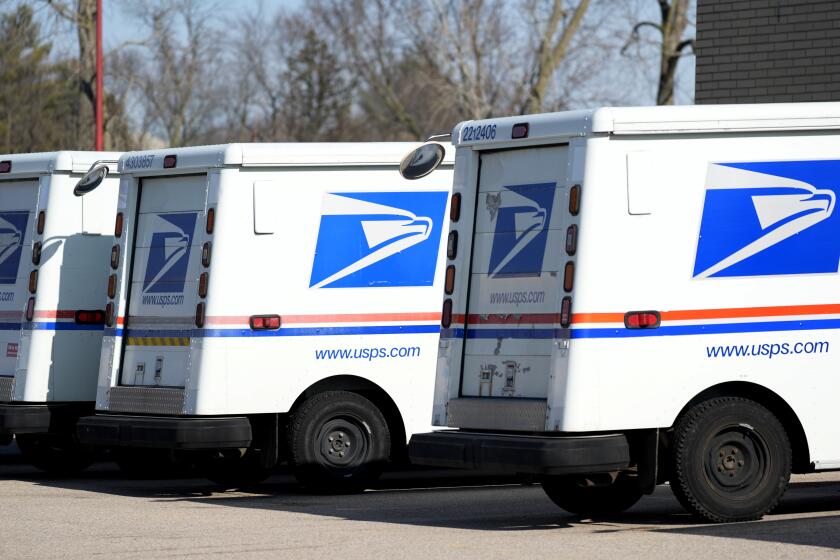Oil and gas firm reactivates long-idle wells near L.A. school after residents seek to plug them

Hoping to force an oil company to plug more than a dozen wells that had been sitting idle next to a Washington Boulevard school, local residents urged the Los Angeles Fire Department to take action.
They pointed to a rarely used section of city code that empowered the fire chief to demand that the company either restart or abandon idle wells. The Fire Department then made that demand.
But instead of plugging the wells, the oil company says it has reactivated them to satisfy the city demands, restoring the flow of natural gas across the street from an Arlington Heights environmental studies academy named for Rachel Carson and Al Gore.
The decision stunned residents. “We thought we had the upper hand,” said Jeff Camp, president of the United Neighborhoods Neighborhood Council, which supported the Fire Department request. “I can’t believe it.”
Eric Kinneberg, a spokesman for Freeport-McMoRan, said in a statement that the Fire Department and state oil officials did a safety and operational inspection before wells were reactivated and that the site was in compliance with city and state regulations.
Community members had raised concerns about the idle wells because if oil or gas wells deteriorate, chemicals, fluids or gases can leak into groundwater or the air.
In recent years, three wells at the 4th Avenue site had failed pressure tests. After more tests, one was plugged and the other two were found to be in line with idle well rules, according to state regulators.
Residents had also worried that leaving wells idle indefinitely could increase the risk that taxpayers would ultimately have to pay to plug them if the oil company fell into financial disarray. Freeport-McMoRan has been battered by plunging prices for oil and faces daunting debt.
In light of those woes, “is the company trying to avoid paying for the required costly cleanup of the site … or stalling in order to sell the site or go bankrupt?” Jefferson Park resident Steven Peckman asked.
West Adams resident Michael Salman said he believed that “if Freeport is reactivating the wells, they’re doing it only as a temporary measure to try to avoid the expense of plugging the wells.”
Kinneberg said the site still had economic value. Any assertions that the city could be left with plugging costs were “unfounded attempts to incite panic,” he wrote.
In a letter urging the Fire Department to act, Salman had called the idle wells “a wholly unnecessary hazard” that were not producing any benefit and should not be allowed “to sit there indefinitely.”
Residents had reason to think the 4th Avenue wells would not be reactivated. When the Los Angeles Unified School District planned the new academy, the company then operating the site, Plains Exploration & Production, said the proximity to a school would trigger a long list of air quality regulations that could make it difficult for them to operate viably.
Oil production halted there more than five years ago — around the opening of the Carson-Gore Academy of Environmental Studies, named for the author of “Silent Spring” and the former vice president. Natural gas continued to flow for a few years longer.
Besides the challenges that oil producers had said were posed by the nearby school, residents had believed there was another obstacle to reactivating the wells: Freeport no longer had state permits for water injection wells at the site.
But the company indicated last week that it did not need those permits because it had instead activated the injection wells for a different purpose — gas production.
Salman said that raised yet another issue. He pointed out that city codes say that converting a well in that way requires city approval, which the company has not yet received.
Kinneberg said it would have been impossible to reclassify the wells in time for the initial city deadline, so the company had activated the former injection wells as a “necessary first step” to show they worked for production, then idled them “to allow time for the reclassification process.”
Fire Department spokesman Peter Sanders said the department would not determine whether the company had satisfied the city demands to plug or reactivate the idle wells until it had heard back from the state Division of Oil, Gas and Geothermal Resources.
State regulators have said their rules lack clarity on when an idle well should be plugged. But L.A. also has its own, stricter rules to nudge companies to plug wells.
The city rules say that after oil wells have been left idle for a year or longer, they must be either shut down or reactivated within roughly a month after the fire chief tells them to do so.
More than 1,100 idle wells are scattered across Los Angeles, according to the state geothermal resources agency. Still more could fall under the same kind of city demand as the 4th Avenue wells, since L.A. rules allow it to take action before California officially deems wells idle.
But Fire Department officials said they could remember only two other cases, both seven years ago, in which they demanded that idle wells be plugged or restarted. Fire officials said they usually target other violations because plugging wells can be costly for the company.
Rock Zierman, chief executive of the California Independent Petroleum Assn., estimated such costs could run from $150,000 to $500,000 per well. He said reviving wells with new technology had allowed companies to avoid the added costs and disturbance of drilling new ones.
“Just to say that a well has happened to be idle for a year, it has to be abandoned even when it doesn’t pose a threat — now you’re taking an asset away from a producer,” Zierman said.
Zierman said idle wells face regular inspections and testing. But some experts say that idle wells can pose a risk because they tend to be less closely monitored than active ones. A report prepared five years ago for the U.S. Environmental Protection Agency warned that existing monitoring of idle wells in California was “not consistent with adequate protection” of underground sources of drinking water.
Without regular testing, “there are no early warning signs until you have undesirable things starting to show up at the surface,” said Robert Bea, professor emeritus at the Center for Catastrophic Risk Management at UC Berkeley.
State rules deem wells idle and say they must be tested if they have not been operating for at least six months in a row during the last five years.
But there are no enforceable, statewide rules about how regularly they must be tested after that point, said Donald Drysdale, spokesman for the state Division of Oil, Gas and Geothermal Resources. Local offices of the agency decide how often to do so based on factors such as groundwater depth, he said.
Twitter: @LATimesEmily
Hoy: Léa esta historia en español
More to Read
Start your day right
Sign up for Essential California for news, features and recommendations from the L.A. Times and beyond in your inbox six days a week.
You may occasionally receive promotional content from the Los Angeles Times.







